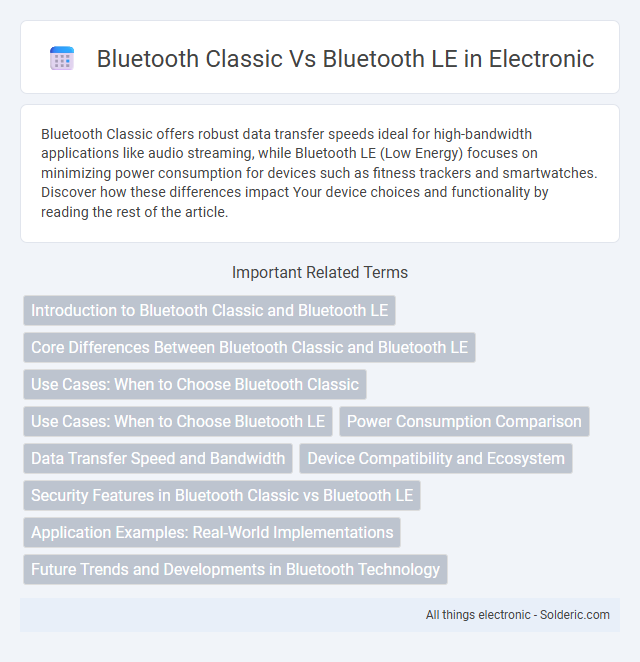Bluetooth Classic offers robust data transfer speeds ideal for high-bandwidth applications like audio streaming, while Bluetooth LE (Low Energy) focuses on minimizing power consumption for devices such as fitness trackers and smartwatches. Discover how these differences impact Your device choices and functionality by reading the rest of the article.
Comparison Table
| Feature | Bluetooth Classic | Bluetooth LE (Low Energy) |
|---|---|---|
| Introduction Year | 1999 | 2010 (Bluetooth 4.0) |
| Primary Use | Audio streaming, data transfer | IoT devices, sensors, low power data exchange |
| Power Consumption | Higher power usage | Optimized for low power, longer battery life |
| Data Rate | Up to 3 Mbps (EDR) | Up to 2 Mbps |
| Range | Typically 10 meters | Up to 100 meters (with Bluetooth 5 and later) |
| Connection Latency | Higher latency | Low latency, faster connection setup |
| Compatibility | Widely supported in audio devices | Common in wearable and sensor devices |
| Data Packet Size | Larger packets, continuous connection | Smaller packets, intermittent connection |
| Security | Secure pairing with SSP | Improved security with AES-128 encryption |
Introduction to Bluetooth Classic and Bluetooth LE
Bluetooth Classic offers robust wireless communication with higher data rates suitable for audio streaming and device connections requiring continuous data transfer. Bluetooth LE (Low Energy) is designed for energy-efficient connectivity in devices like fitness trackers and smart home sensors, optimizing battery life with intermittent data transmission. Your choice depends on the balance between data rate requirements and power consumption for your specific application.
Core Differences Between Bluetooth Classic and Bluetooth LE
Bluetooth Classic offers higher data rates up to 3 Mbps, making it suitable for audio streaming and continuous data transfer, while Bluetooth LE prioritizes low power consumption with data rates of 125 kbps to 2 Mbps, ideal for intermittent data transmission in IoT devices. Bluetooth Classic uses a continuous connection-oriented communication method, whereas Bluetooth LE employs a connectionless advertising and scanning approach, optimizing power efficiency. Core protocol differences include Bluetooth Classic operating on the BR/EDR (Basic Rate/Enhanced Data Rate) standard and Bluetooth LE leveraging the LE PHY layer introduced in Bluetooth 4.0 for reduced latency and improved energy efficiency.
Use Cases: When to Choose Bluetooth Classic
Bluetooth Classic is best suited for use cases requiring continuous, high-bandwidth data transmission, such as wireless audio streaming and hands-free calling in automotive systems. Its stable connection and higher throughput make it ideal for devices like stereo headsets, in-car kits, and other audio peripherals. Your choice should favor Bluetooth Classic when uninterrupted, real-time audio quality is a priority over power consumption.
Use Cases: When to Choose Bluetooth LE
Bluetooth LE excels in battery-sensitive applications like fitness trackers, smartwatches, and medical devices where prolonged operation is critical. It is ideal for intermittent data transmission and low-bandwidth scenarios, such as sensor networks, asset tracking, and smart home automation. Choose Bluetooth LE for enhanced energy efficiency, longer device battery life, and seamless connectivity in IoT ecosystems.
Power Consumption Comparison
Bluetooth LE (Low Energy) significantly outperforms Bluetooth Classic in power consumption, designed to operate with minimal energy use for extended battery life in devices like fitness trackers and IoT sensors. Bluetooth Classic demands higher power due to continuous data transmission, making it less suitable for battery-sensitive applications. Your choice between Bluetooth Classic and Bluetooth LE should depend on device usage patterns and battery longevity requirements.
Data Transfer Speed and Bandwidth
Bluetooth Classic offers higher data transfer speeds, typically up to 2-3 Mbps, making it suitable for applications requiring continuous data streaming such as audio playback and file transfers. Bluetooth Low Energy (LE), designed for minimal power consumption, supports lower data rates generally up to 1 Mbps, optimizing performance for sensor data and intermittent communication. Bandwidth allocation in Bluetooth Classic favors sustained high-throughput connections, while Bluetooth LE prioritizes efficiency and reduced latency for short bursts of data.
Device Compatibility and Ecosystem
Bluetooth Classic offers broad device compatibility across smartphones, laptops, and audio equipment, making it ideal for high-quality audio streaming and file transfers within established ecosystems. Bluetooth Low Energy (LE) targets a rapidly expanding ecosystem of IoT devices, wearables, and sensors, prioritizing energy efficiency to extend battery life in compact gadgets. Your choice depends on whether you need widespread compatibility and robust data rates (Bluetooth Classic) or a modern, power-savvy connection for smart, interconnected devices (Bluetooth LE).
Security Features in Bluetooth Classic vs Bluetooth LE
Bluetooth Classic employs robust security features including Secure Simple Pairing (SSP) with Elliptic Curve Diffie-Hellman (ECDH) for key generation, providing strong protection against eavesdropping and man-in-the-middle attacks. Bluetooth Low Energy (LE) enhances security with LE Secure Connections, utilizing the same ECDH cryptographic algorithm but optimizing power consumption for resource-constrained devices. Both protocols support encryption, authentication, and privacy features, but Bluetooth LE offers improved resistance to passive eavesdropping and better privacy options through address randomization.
Application Examples: Real-World Implementations
Bluetooth Classic is commonly used in applications requiring continuous, high-throughput data streaming such as wireless audio devices, headphones, and hands-free car systems. Bluetooth Low Energy (LE) excels in battery-sensitive applications like fitness trackers, smart home sensors, and medical devices, where infrequent data transmission and long battery life are critical. Real-world implementations showcase Bluetooth Classic in Bluetooth speakers and gaming controllers, while Bluetooth LE powers smartwatches and proximity beacons.
Future Trends and Developments in Bluetooth Technology
Bluetooth LE is rapidly advancing with enhanced data rate and lower power consumption, making it ideal for IoT and wearable devices. Future trends indicate seamless integration of Bluetooth Classic and LE for improved connectivity and extended device compatibility. Your devices will benefit from increased range, security improvements, and smarter energy management technologies in upcoming Bluetooth standards.
Bluetooth Classic vs Bluetooth LE Infographic

 solderic.com
solderic.com